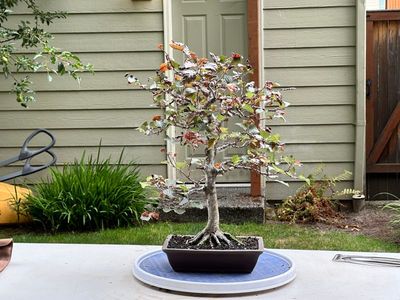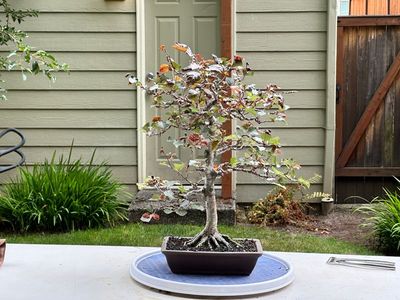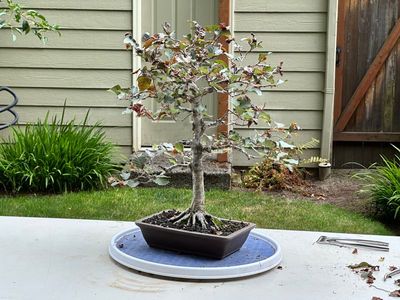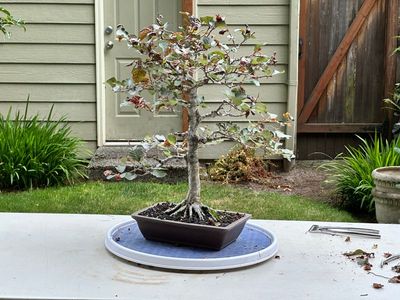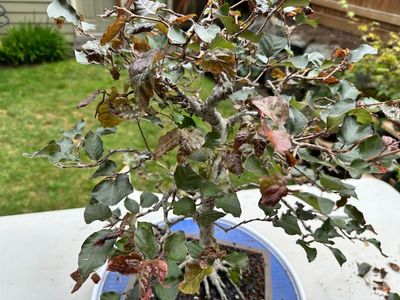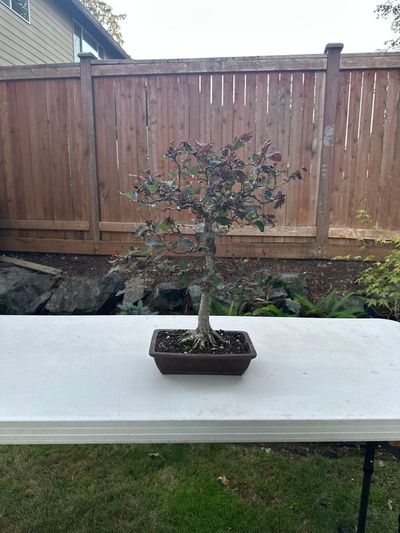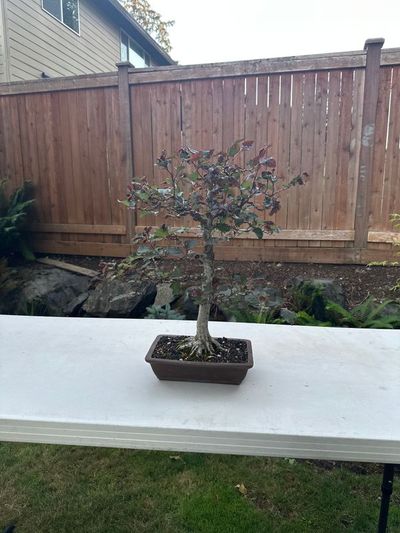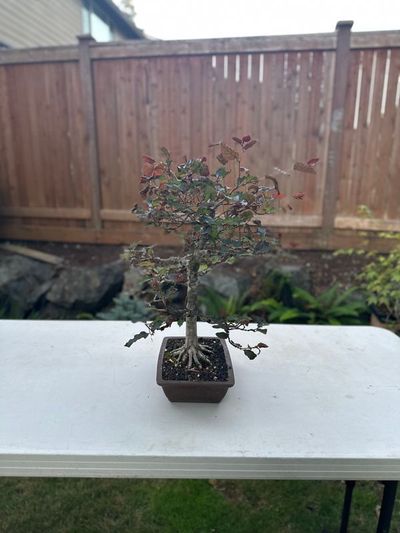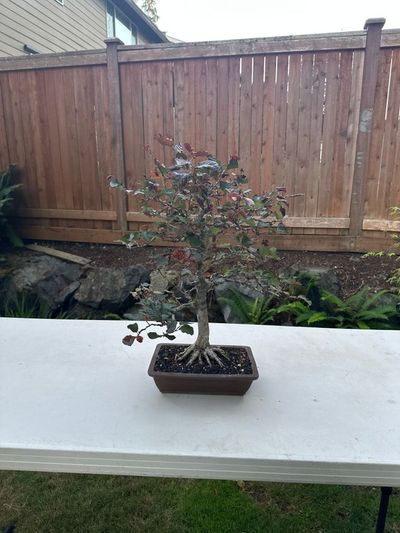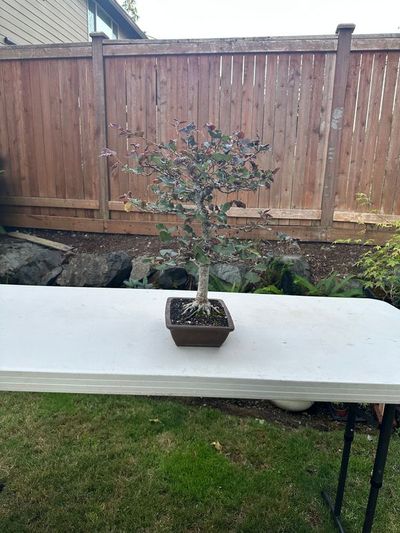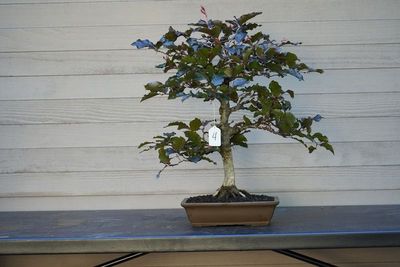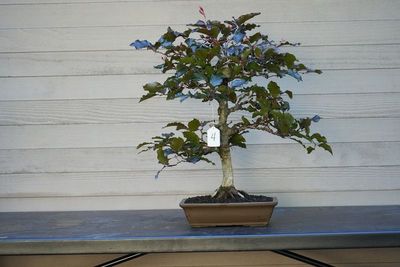My Trees > Copper Beech 1
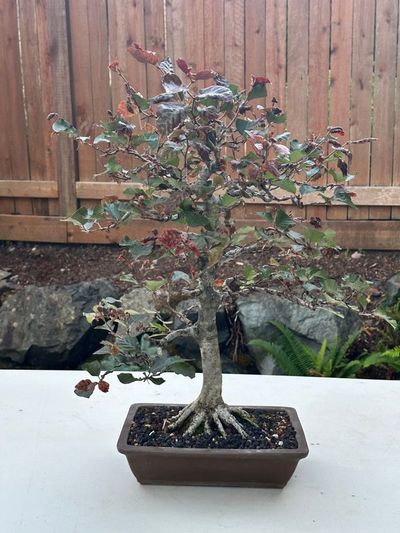
Purple Beech from 2025 PSBA Auction
Provenance
Beech - Informal Upright (Submitted by Millie Russell, assisted by Eric Ridgeway). This deciduous beech, styled in an informal upright form, stands at 22" tall and 15" wide and deep, housed in a brown bonsai rectangle pot. While the exact age is uncertain, the tree has at least 16-17 years of history, originating from the Lone Pine Nursery (Sonoma CA?). It has been under active refinement since 2015, with prior work noted but unspecified. The foliage develops a beautiful reddish-brown coloration in season, suggesting strong autumn interest and mature leaf character. Two photos were submitted to document its current state.Background
- Estimated Origin: June 2008
- Training Since: June 2015
- Acquired: June 7, 2025
- Progression: Bonsai
Tree Details
- Style: Informal Upright
- Exhibition Ready: No
Notes
Gorgeous tree and looking forward to taking it to the next level of ramification and development. Incredible nebari.
About Copper Beech 1
This copper beech carries over a decade of refinement and a lineage that likely stretches back to Lone Pine Nursery in California. Styled in an informal upright form, the tree now stands at 22 inches tall, its silhouette a balanced canopy of deep purple foliage and textured gray bark. The base flares gently, with firm nebari anchoring it to a clean, rectangular pot.
Acquired through the 2025 PSBA auction, this beech has responded well to careful leaf pruning and sensitive seasonal work. New growth has emerged following a reduction cut, offering promising internal budding and structure refinement. While not yet exhibition-ready, its structure is clear and its presence already compelling.
This is a tree of quiet resilience, a tree that doesn’t shout, but listens. Its branching is imperfect, its trunk marked by the shaping of time and intention. The more you sit with it, the more it offers. It’s not here to impress. It’s here to endure, to invite, and to teach.
10-Year Plan for Copper Beech 1
This tree has already been listened to. Now it needs time to be understood. I don't feel the need to push this tree. I'll walk beside it, season after season, until it slowly becomes something inevitable.
A copper beech doesn’t bloom. It doesn’t fruit. But it still dazzles. Treated with patience, light, and dignity, it carries a richness and depth that other trees can’t fake. In ten years, this tree won’t just be refined. It’ll be quietly unforgettable.
Years 1–2: Stability, Light, and Observation
-
Let the tree recover from recent stress: heat, leaf work, and rewiring. No aggressive pruning.
-
Focus on watering precision and light seasonal misting. Copper beech prefers even conditions, not extremes.
-
Begin slow refinement:
- Thin interior growth to encourage back budding.
- Continue leaf reduction mid-season if health supports it to allow light internally and balance energy.
- Map the branch zones: Which will be primary structure? Which are temporary fillers?
My goal is to learn the tree’s behavior - where it wants to bud, where it resists, how it responds to heat and cuts.
Years 3–5: Structural Refinement and Form
- Early spring: clean structural pruning, refine trunk-line branches, and begin taper development on secondaries.
- Use guy wires or clip-and-grow over aluminum wire wherever possible—scarring is a long-term liability on beech, and already an issue I have to deal with.
- Continue selective defoliation mid-season, only on strong areas, to tighten internodes.
- Repot once during this period (year 3 or 4), just before bud swell. Maintain strong nebari and radial root health.
This phase is about unlocking the tree’s internal architecture, building rhythm without rushing detail.
Years 6–8: Ramification and Subtle Expression
- Focus shifts toward fine branching, silhouette layering, and balance.
- Begin seasonal silhouette shaping. Allow some flushes to extend, others to remain tight.
- If appropriate, lightly scarify or expose subtle deadwood zones to add age, but only if tree is vigorous.
- Consider upgrading the pot or planting angle if it strengthens the tree’s stance and balance.
This is when the tree begins to speak for itself. I should be mostly responding, not directing.
Years 9–10: Readiness and Sharing
- Prepare for possible display or photo documentation. Choose the season that best reveals the tree’s essence (early spring silhouette or late autumn foliage).
- Shift to minimal intervention: light pruning only, strong feeding early in the year, and stable watering.
Care Log
-
July 19, 2025
Unwire
I reviewed the leaves which were wilted and didn't see any real change. It seems like the tree is pretty stable now. I noticed that the wiring on the tree was starting to cut into the bark so removed all the wire. I added some back on some of the younger straight branches which were no wired previously. There are some wire marks. Super unfortunate. Not happy about it.
-
July 14, 2025
Observation
Took some photos today.
-
July 11, 2025
Observation
My leaf reduction technique was well-executed. Removing ~¼ and reducing the rest encouraged internal light, better airflow, and controlled backbudding. The flush of new growth afterward? An amazing good sign. But: New leaves are tender—they don’t yet have the waxy cuticle or lignin support to handle heat. In a heat spell, transpiration outruns root supply, especially if the roots were already working hard post-defoliation. There was some wilting, likely transpirational stress, not failure. I'm giving the tree some additional watering and some shade in the heat of the day.
-
July 2, 2025
Leaf Prune
Removed 1/4 leaves, trimmed most others in half, curved across the tip. Want to allow light and airflow to encourage health and budding.
-
June 7, 2025
Other, Acquired
Purchased from 2025 PSBA Auction for $440 (Millie, client of Eric Ridgeway)
 Mossy Spot
Mossy Spot
